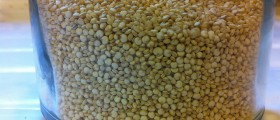
Celiac disease is an autoimmune disorder of the small intestine. It occurs in genetically predisposed people and may appear at any age, from the middle infancy to the elderly. Symptoms of the disease are triggered upon the consumption of the protein gluten, usually found in bread, pasta, cookies, pizza crust and many different foods containing wheat, barley or rye. The immune reaction in the small intestines causes damage to the inner surface of the small intestine and an inability to absorb certain nutrients. The accompanying symptoms are abdominal pain and diarrhea, followed by malabsorption and vitamin deficiencies that deprive the patient’s brain, peripheral nervous system, bones, liver and other organs.
How agricultural revolution changed human eating habits
It is estimated that the celiac disease first time appeared in the Neolithic period, when humans first started to cultivate grains. Before this era, human diet mainly consisted of fruits, nuts, possibly tubers and the occasional treats of meat. Humans ate only what they could hunt or gather from their close environment. For over 2 million years, human intestine has developed into a delicate organ capable to tolerate food antigens that were staples of the human diet over such a long period of time. The Neolithic period introduced a true agricultural revolution and introduced many foods previously unknown to humans. These included protein from cow, goat and donkey milk, as well as birds’ eggs and cereals. Humans, at least the great majority of them, adapted to the new foods and food antigens, but among those who were not able to adapt, appeared first food intolerances.
History of celiac disease
Greek physician named Aretaeus of Cappadocia, in the first century AD, first identified and named celiac disease. He named it “koiliakos”, after the Greek name for abdomen - “koelia”. In the early 19th century Dr. Mathew Baillie published his investigations on a chronic diarrheal disorder of adults characterized by severe malnutrition and bloated abdomen. Unfortunately, these observations were unnoticed until the English doctor Samuel Gee made a complete modern description of celiac disease in 1887. Doctor Gee understood the complexity of food intolerances and suggested: “if the patient can be cured at all, it must be by means of diet.” Furthermore, he added, “the allowance of farinaceous food must be small”, and recommended the introduction of a gluten-free diet. Doctor Gee also published his observations on relapse after reintroduction of gluten. The Dutch pediatrician Dr. Willem-Karel Dicke was first to discover a link between celiac disease and wheat, in 1940s. He noticed that he shortage of bread led to a significant drop in the death rate among children affected by celiac disease. The link with the gluten component of wheat was finally made in 1952 by a team from Birmingham, England.

















Your thoughts on this
Loading...